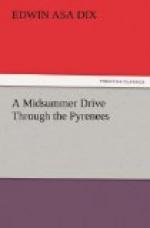After the evening dinner, we explore the street on the other side of the triangle. We find a narrow cut in the rocks behind the houses, and, passing through, a few steps bring us out upon the view of the main ravine, from which this narrow curtain of rock shuts off the town. The contrast is instantaneous. From the hemmed-in nest of streets we have suddenly emerged upon the long sweep of the valley below us, finely commanded by the ledge where we stand. The level plunges off abruptly down to the Gave, which speeds toward Laruns, “leaping through a wild vegetation and ‘shepherding her bright fountains’ down a hundred falls.” A few houses cluster on the hill as it goes down and at its base, but the torrent is again banked in by the mountain opposite, which climbs high above our own level. There is a long view up and down the valley, still and quiet in the gloaming. The night falls almost while we linger, and at length we turn back through the cut and saunter again across the park.
Passing the line of booths, we keep on toward the Casino, which is elevated some feet above the street in front. Its windows are lighted up; people are entering the building; a concert is about to commence. Before following them we pause for a while upon the terrace to turn and face the Pic de Ger. Erect and regal, its height throws it, alone among the surrounding mountains, into the full evening after-light; its precipices and white summit are all aflame still with the red sun, already lost to the valley. The great peak glows like the sacred pillar of fire by night, and we cannot but gaze at it long and reverently.
VI.
Sunday is more quietly kept by Eaux Bonnes than might be expected. The little French chapel has its service, and there is a certain staidness about the morning which is unlooked-for and refreshing. The shops, however, are open as always; the vinaigrette-dragowomen as energetic as commonly; and in the afternoon the band plays in the kiosque as it does on week-days. In fact, except for this certain staider air, the place like other Continental resorts does on Sunday very much the things which it does on other days of the week.
The springs of course are as regularly sought. Their routine cannot yield to religious institutes. These waters are chiefly useful in throat and lung diseases, though the baths are healing for abrasions and wounds. Both hot and cold waters are here; at one spot, oddly enough, the two temperatures well up close together. The springs have long been known, and anciently, as now, they were more popular than those of the sister valley. One of the kings of Navarre sent hither disabled soldiers from his wars in Italy; many had been wounded by the arquebus, then a new weapon, and from the cures effected, the waters were called after its name. They are seven in number, ardently sulphureous and officiously odorous. They are not to be dealt with in the spirit of levity of Eaux Chaudes’ “sober young German”: fifty glasses are not lightly to be tossed off. “Caution is necessary,” warns Murray, “in using these waters; bad consequences have arisen from a stranger taking even a glassful to taste. It is usual to begin with a table-spoonful and a half!”




